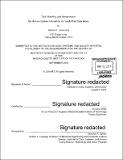Task modeling and assessment for human-system interaction in freight rail operations
Author(s)
Groshong, Hannah L
DownloadFull printable version (11.07Mb)
Other Contributors
Technology and Policy Program.
Advisor
Charles Oman.
Terms of use
Metadata
Show full item recordAbstract
As technological advancement continues and the usage of automation in the cab of a locomotive grows, the role of the locomotive engineer and conductor changes. There is a need then to better understand the impact of different task allocations, or configurations of tasks, among the human and automation agents. The technical objective of this thesis was to investigate whether the workload of the locomotive engineer could be predicted from a task model of the role of the engineer and conductor and their interactions with automation in rail operation. A task model was developed by reviewing existing Cognitive Task Analyses, and also by using concept mapping to identify information gaps which were then filled via expert interviews. Engineer and conductor goals and priorities were formalized in an Abstraction Hierarchy. This included controlling train speed, train forces, and dispatcher communications, while maintaining awareness of train and signal states, track conditions, and nearby traffic. Hierarchical Task Analysis was used to identify the lower level tasks of the engineer and conductor when driving manually in traditional fashion, or when using two alternative levels of throttle, brake, horn, in cab signaling and pacing automation. Engineer mental workload was predicted based on the number of information inputs and actions required, and an analysis of when the engineer would be engaged in the specific tasks while driving a route. To validate the task model based workload prediction, a human-in-the- loop experiment was conducted in a DOT locomotive simulator. Eleven subjects drove the same route manually and under the two automation conditions. Response time to a visual secondary task was used as a proxy measure for mental workload. Hierarchical mixed regression analysis was performed to compare the secondary task response time with the workload predications from the task model, which incorporated the three automation effects. Response time correlated significantly with the modeled workload. The ratio of experimental response time to predicted workload depended significantly on subject, automation condition, and along track distance effects. The task model slightly (2%) under/overestimated mean effects of automation and average response time. However other un-modeled effects also contributed to the regression residual, as discussed. A second objective of this thesis was to consider whether the qualitative information contained in the concept maps, CTA analyses, and formal task models on the role of the engineer and conductor and their interaction with automation could be useful in policy discussions. Several potential benefits of using this information were identified: it can educate people on the job of the engineer and conductor in rail operations, it can be a shared language for stakeholders to use in discussion of the future of rail automation, and it can promote knowledge translation between researchers and policymakers. However, several steps need to be taken to get the information from the task model into an accessible form for use in policy discussions. These include creating a visual and interactive tool to display the information and involving stakeholders in the development process.
Description
Thesis: S.M. in Technology and Policy, Massachusetts Institute of Technology, School of Engineering, Institute for Data, Systems, and Society, Technology and Policy Program, 2016. This electronic version was submitted by the student author. The certified thesis is available in the Institute Archives and Special Collections. Cataloged from PDF version of thesis. Includes bibliographical references (pages 73-76).
Date issued
2016Department
Massachusetts Institute of Technology. Engineering Systems Division; Massachusetts Institute of Technology. Institute for Data, Systems, and Society; Technology and Policy ProgramPublisher
Massachusetts Institute of Technology
Keywords
Institute for Data, Systems, and Society., Engineering Systems Division., Technology and Policy Program.